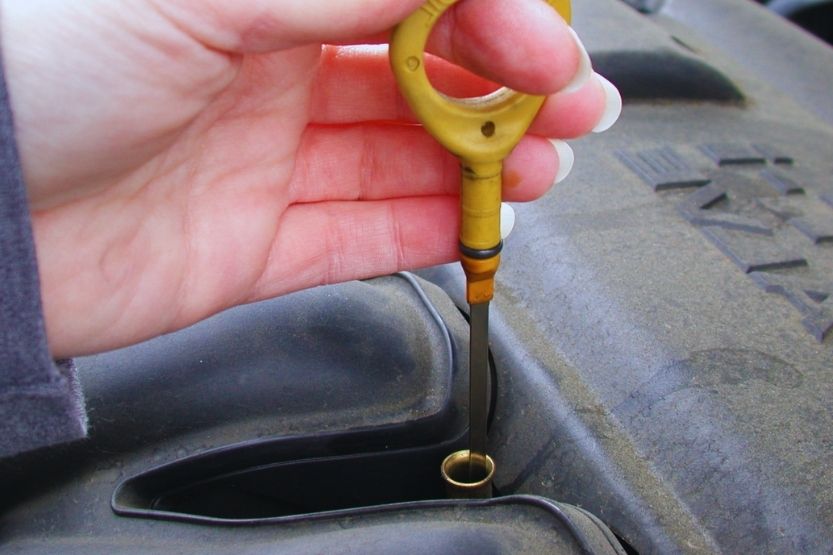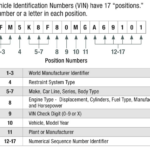When you’re filling engine oil into your car, you should always know how much of it you are putting in. If you put in too little oil, the engine can get damaged due to increased friction. But putting in too much will cause the oil to get frothy, leading to increased wear and tear of the engine’s internal components. This is why you need to know how to read a dipstick.
Here are the steps for reading an oil dipstick:
- Consult Your Owner’s Manual
- Park Your Car on a Surface Level
- Lift the Hood of Your Car
- Locate the Oil Dipstick
- Pull Out the Dipstick
- Wipe the Dipstick Clean
- Take an Oil Reading
- Wipe the Dipstick Before Returning It
Read on to learn more about how to read a dipstick, the difference between oil and transmission dipsticks, and more.
How to Read a Dipstick

Your car’s engine requires an optimum amount of motor oil in the tank. To make sure that it does, you need to gauge the oil in your car using a dipstick.
So. here are the steps for reading an oil dipstick:
- Consult Your Owner’s Manual
- Park Your Car on a Surface Level
- Lift the Hood of Your Car
- Locate the Oil Dipstick
- Pull Out the Dipstick
- Wipe the Dipstick Clean
- Take an Oil Reading
- Wipe the Dipstick Before Returning It
Let’s talk about each of these steps:
1. Consult Your Owner’s Manual
Different car manufacturers have varying requirements for gauging the engine oil effectively. Refer to the owner’s manual of your car to find out the best temperature that the manufacturer recommends for inspecting oil.
2. Park Your Car on a Surface Level
Make sure to park your car on a level surface when you’re trying to gauge your engine’s oil level. If your car is parked in a slanted area, it will shift the oil’s position in the engine. This will affect the amount of oil the dipstick can access. Also, it’ll make it difficult to get a proper reading.
3. Lift the Hood of Your Car
There has to be a latch that enables you to easily lift the hood covering the engine bay of your car. Depending on the kind of vehicle, you can locate the latch anywhere in the automobile. You may have to push or pull it to release the latch that secures the hood of the car.
Then, try to look for another latch below the hood. When you find it, push or pull it to open the hood. That way, you’ll gain access to the engine bay.
Some car hoods are equipped with springs to stay up with no support. You may need to use a prop for hoods that do not have this mechanism to keep it open. Whichever the case, you will need to keep the hood up to make the next step easy for you.
4. Locate the Oil Dipstick
To find the dipstick, you may need to consult the owner’s manual of your car. The oil dipstick is a long pencil-thin metal stick. It measures at least a foot in length. This is fitted with a plastic ringed handle that you grasp to pull it out.
Depending on the car, an oil dipstick will usually have a yellow, red, or orange cap with oil can sign on it. Typically, it will have a circular or rectangular shape. You may find it around the engine block.
With that being said, the location of the dipstick will depend on the car. Some cars have dipsticks sticking out at the top of the valve cover. But other cars have dipsticks located close to the front of the engine bay.
5. Pull Out the Dipstick
After you have found the dipstick, pull it out gently. Do this while holding a clean rag or paper towel around the port where you’re pulling it out from. That way, you’ll prevent oil from spilling out from the port when the dipstick is pulled out.
Remember not to force the dipstick out. Just give a ring on top of the cap a firm grip and pull.
6. Wipe the Dipstick Clean
Clean the dipstick using a rag or paper towel after pulling it out. This is because you will be immersing it back into the port for a second time afterward.
It’s usually difficult to accurately gauge the dipstick reading when pulled out the first time. That’s why you have to wipe the dipstick clean before you take a second reading.
When you wipe the dipstick, start from the top to the end tip. But before you start wiping, you should first check the condition of the oil. This includes its color and constituents.
7. Take an Oil Reading
After wiping the dipstick clean, you need to dip it in for a second time. Then, pull it back out and scrutinize it. You should see holes, letters, or lines on the dipstick which indicate the engine’s oil level.
F for Full and L for Low
A dipstick will have the letters F for Full and L for Low in certain cars. At the same time, others will only have two or more small holes or a sequence of lines marking these spots.
Check the Manual for Verification
You will have to refer to the owner’s manual again to verify what it says regarding the oil dipstick markings. Typically, the lowest marking is usually nearest to the dipstick’s tip. Then, the highest would be closer to the dipstick’s cap.
If the oil is situated between the markings, the closer it is to the top, the better. It means the engine oil is at optimal levels. But you can also find the oil close or below the markings to the end of the dipstick’s tip. In which case, you have to add some engine oil.
At any rate, if the oil goes over the upper mark, you’ll have to drain it out. Then, keep the oil at a normal level.
Again, how to read a dipstick? Your dipstick has two marks, which stand for Low and Full. In this case, the oil level should be between the said marks. If your car has a cross-section instead of marks, ensure that the oil level is within the cross-section. Read your manual if in doubt.
8. Wipe the Dipstick Before Returning It
Once you have taken the dipstick reading, wipe the oil off the dipstick before returning it to its port:
How Do You Read a Transmission Dipstick?

This time, let’s talk about the steps on how to read a transmission dipstick. These include the following:
- Warm Up the Car
- Park and Idle the Car
- Lift the Hood
- Locate the Transmission Dipstick
- Pull Out the Dipstick and Read
Let’s briefly explain each of them:
1. Warm Up the Car
Before measuring your transmission fluid levels, you should first drive your car for 10 minutes or so. That way, you can heat the motor and expand the transmission fluid.
Doing this will allow you to get a more accurate reading on the transmission dipstick. The transmission fluid is petroleum-based and expands when it heats up.
2. Park and Idle the Car
Ensure that you park your car on a flat and level surface. Then, put your foot on the brake and shift the transmission lever through all the gears. Stay in each gear for three seconds. Then, place the car in park and leave the engine running.
3. Lift the Hood
Find the release hatch of the hood directly below the hood’s front center. To open the hood, you have to slide the latch to the left. Then, secure it using the metal hood prop. It lies flat on the fender well’s right-hand side.
4. Locate the Transmission Dipstick
The transmission dipstick usually features a red or black handle. That way, it will not confuse you with the yellow or orange engine oil dipstick. You should find it on the right side of the motor close to the firewall. But it can also be on the left side of the exhaust manifold at the front of the motor.
5. Pull Out the Dipstick and Read
Take out the dipstick and use a shop rag to wipe it clean. Reinsert it into the dipstick tube, then remove it for a second time. Read the markings on the dipstick, which indicate if the transmission fluid is full or low. If the transmission fluid level is low, you will need to add fluid.
FAQs – How to Read a Disptick

What Is an Oil Dipstick?
All internal combustion engines come with an engine oil dipstick, including diesel engines. It is a long, flat metal rod with a looped handle. This serves to measure the oil level in the engine of a car.
The oil dipstick can also perform other functions. It can inform you about the condition of the oil, as well as the engine’s internal health.
What Is a Transmission Dipstick?
The oil dipstick is used to measure the level of engine oil. At the same time, the transmission fluid dipstick measures the level of transmission fluid in the car. It is just as important to know how to read a transmission dipstick. This is because low fluid levels may indicate problems with the transmission.
A transmission fluid’s chemical properties break down over time. But the fluid itself stays at its proper level unless something is wrong. If you’re checking the transmission dipstick properly and continuously adding fluid, there is a leak somewhere in the system.
What Do the Lines on a Dipstick Mean?
An oil dipstick has measurement markings that indicate the engine’s maximum and minimum oil level. The difference between the levels is usually one quart. If the oil is below the minimum mark, you must add oil.
The markings typically come in lines, letters, or small holes. Refer to your owner’s manual if you don’t know how to read a dipstick with holes, lines, or letters. You can also consult a professional.
What Do the Holes on a Dipstick Mean?
It is not difficult to know how to read a dipstick with holes. The dipstick features four holes. The topmost stands for the highest point of the oil when it is hot.
The hole next to it means the highest point when the oil is cold. The uppermost one closest to the tip is the lowest point when the oil is hot for the last two holes. The hole nearest the dipstick’s tip is the lowest point when the oil is cold.
Conclusion – How to Read a Dipstick
So, to recap, here again, are the steps for reading an oil dipstick:
- Consult Your Owner’s Manual
- Park Your Car on a Surface Level
- Lift the Hood of Your Car
- Locate the Oil Dipstick
- Pull Out the Dipstick
- Wipe the Dipstick Clean
- Take an Oil Reading
- Wipe the Dipstick Before Returning It
For the steps for reading a transmission dipstick, they are the following:
- Warm Up the Car
- Park and Idle the Car
- Lift the Hood
- Locate the Transmission Dipstick
- Pull Out the Dipstick and Take a Reading
The oil and transmission dipsticks are vital components fitted into your car. They enable you to check the level of your oil and transmission fluids manually. It is important to regularly check the fluid levels in your car to make sure that it is in good working order.

![How to Use Fix-a-Flat [8 Easy Steps] how to use fix-a-flat](https://roadsumo.com/wp-content/uploads/2022/03/how-to-use-Fix-a-Flat-150x150.jpg)
![How to Put Chains on Tires [Easy Steps] how to put chains on tires](https://roadsumo.com/wp-content/uploads/2022/01/how-to-put-chains-on-tires-150x150.jpg)


![How to Transfer a License Plate to a New Car [in 4 Steps] transfer license plate to new car](https://roadsumo.com/wp-content/uploads/2022/02/transfer-license-plate-to-new-car-150x150.jpg)



![Read more about the article How Much Is an Oil Change at Valvoline? [Valvoline Oil Change Prices]](https://roadsumo.com/wp-content/uploads/2021/05/how-much-is-an-oil-change-at-Valvoline-300x200.jpg)